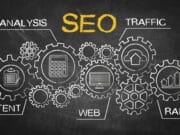If you are still confused with content marketing vs context marketing, you’d better stop it right now because that’s the case when one small letter makes a huge difference. The content was a king for a long time, but today the crown belongs to the context. If your content doesn’t hit the target, it does not matter how good it is. This is where context marketing comes into play: it aims to make the customer get the proper content at the right time and place. Long story short, context marketing is about personalization. And if you want this personalization to be successful, check out the following 7 things to do.
1. Watch their every move
 There is no other way to know what makes your customers tick but to follow them everywhere (of course, not literally). Here is what you need to know about them:
There is no other way to know what makes your customers tick but to follow them everywhere (of course, not literally). Here is what you need to know about them:
- Which blog did they read yesterday evening?
- Which Instagram photo did they post from California?
- Which social media do they use the most?
2. Segment customer’s database
 Database segmentation helps you to send your offer to those customers who are the most likely to need it. For example, a sporting store is running a sale on bike accessories. Instead of sending invitations to all of the registered customers, they are sent to those who have already bought a bike.
Database segmentation helps you to send your offer to those customers who are the most likely to need it. For example, a sporting store is running a sale on bike accessories. Instead of sending invitations to all of the registered customers, they are sent to those who have already bought a bike.
Segmentation creates leads instead of transferring your offers into spam or junk emails. Remember that people won’t pay attention to your letters or may even unsubscribe if your content is not what they need.
The majority of segmentation methods include the following variables:
- Frequency – amount of orders over a chosen period of time
- Monetary – amount of money spent
- Recency – last placed order
- Location: This feature is very helpful when you want to localize your product or service. For example, you have a number of stores all over the country. When sending promotional emails, geolocation can help you to identify the stores to be included in the text, so the clients don’t need to search for an address.
- Gender: The Male audience is unlikely to appreciate discount coupons for embroidery stuff. Gender segmentation will ensure that men get men’s toys and so do women.
- Language: Companies that sell their products worldwide usually send newsletters and promos in recipients’ native languages. And that’s really helpful. Segment your mailings if you don’t want them to get into the trash.
- Birthday: Everybody likes receiving additional discounts and promotions for B-days. This heartwarming gesture will definitely increase loyalty.
- Interests: If you know what the customer likes, you can miss a chance to use it. Send him/her personal discounts on football accessories, classic watches, or whatever he/she is interested in.
- Education: If you want to promote an internship program in foreign countries, education segmentation will help you to find the most proper audience. Recent graduates or last-year students are just what you are looking for.
- Relationship: Adult men’s club invitation for married guys? There is hardly any chance this can work. This is where relationship segmentation will help.
3. Use tools to improve customer interactions
 One of this tools is CJM (Customer Journey Map). The idea is very simple: the map tells a story of customer’s engagement with your company starting from the initial contact. You need CJM to build a solid relationship with your client, make him/her loyal and ensure collaboration at every stage.
One of this tools is CJM (Customer Journey Map). The idea is very simple: the map tells a story of customer’s engagement with your company starting from the initial contact. You need CJM to build a solid relationship with your client, make him/her loyal and ensure collaboration at every stage.
There is no single formula or standard view for CJM. However, most of them look like infographics.
Here are a few examples what you can do with CJM:
- Identify the gaps between channels (i.e. Facebook → website)
- Figure out device support problems
- Identify junk emails
4. Work with social media
 You know what a focus group is, right? Imagine that social media is a very big focus group, which lets you analyze your brand appearance over the internet. And you don’t even need to ask users’ permission to do it. Simply use various tools to find out what people think about your product, what impact your advertising campaign has, what your customers’ values are, etc.
You know what a focus group is, right? Imagine that social media is a very big focus group, which lets you analyze your brand appearance over the internet. And you don’t even need to ask users’ permission to do it. Simply use various tools to find out what people think about your product, what impact your advertising campaign has, what your customers’ values are, etc.
Indeed, social media can do you good. It is an endless source of data. Just grab it and use wisely.
5. Combine customer’s info from various sources
 Yes, social media is a solid piece of data, but for better context marketing you need something beyond. Combine customer’s information from different sources and analyze it all together. This is the way you can improve the accuracy and better personalize each customer. Here are some sources you can benefit from:
Yes, social media is a solid piece of data, but for better context marketing you need something beyond. Combine customer’s information from different sources and analyze it all together. This is the way you can improve the accuracy and better personalize each customer. Here are some sources you can benefit from:
- Social media (of course!)
- Web
- Loyalty programs
- Interviews
- Surveys
- Outsourcing providers
Fact: Only 20% of news are shown in your Facebook feed. Others are filtered.
One of the most effective ways to create stunning content is to use the power of newsbreaks. People want to read, watch and listen to what’s happening right now: news, holidays, trends, days from history, showbiz, etc. If you catch the right moment when the topic is just gaining momentum and add a little bit of creativity to your post, it can easily become viral. But if the trend is already overused, you’d better skip it.
6. Use triggers and events
 Triggers: Triggers help you to play your cards right. For example, a customer added several items to his shopping cart in your online store but didn’t finish the order. In order to encourage the customer to buy the product, you need to send a letter-reminder. Now, chances that the customer will complete the purchase are much higher. In this case, abandoned shopping cart is a trigger. Of course, sending emails manually is out of the question. There are quite a bit of tool to automate your triggers.
Triggers: Triggers help you to play your cards right. For example, a customer added several items to his shopping cart in your online store but didn’t finish the order. In order to encourage the customer to buy the product, you need to send a letter-reminder. Now, chances that the customer will complete the purchase are much higher. In this case, abandoned shopping cart is a trigger. Of course, sending emails manually is out of the question. There are quite a bit of tool to automate your triggers.
Other triggers’ examples include:
- Activation email
- Welcome email
- Life-cycle based email
- Birthday greetings
- Special discount email for loyal customers
- The customer has placed an order
- The order has been successfully delivered
- The customer has edited his profile
- The customer has left a review
Events: True context marketing mastery is to use predicted and unpredicted events to develop your business. A good example is an April fool by Virgin Airlines to launch the first ever glass-bottomed jet. Although the post appeared on the 1st of April, many mass media re-posted the news in all seriousness. The joke did not cost the company a penny but made people talking about it once again.
On second thought, every event can be profitable for your brand. All you need is to be creative.
7. Control the full marketing process
 Starting from data collection and finishing with marketing campaigns – every step should be under control. Moreover, every next activity should be based on the previous one. Bring together all parts of your context marketing and run campaigns over various channels. If you have a big team, make sure that the collaboration between all participants is going smoothly.
Starting from data collection and finishing with marketing campaigns – every step should be under control. Moreover, every next activity should be based on the previous one. Bring together all parts of your context marketing and run campaigns over various channels. If you have a big team, make sure that the collaboration between all participants is going smoothly.
Finally:
 Achieve mind-blowing results at the lowest cost. If properly harnessed, context marketing will ease your business, automate the processes, increase brand awareness, and definitely, increase your income. The reason is simple: it allows to offer the customer exactly what he/she wants. And this is the key.
Achieve mind-blowing results at the lowest cost. If properly harnessed, context marketing will ease your business, automate the processes, increase brand awareness, and definitely, increase your income. The reason is simple: it allows to offer the customer exactly what he/she wants. And this is the key.
This article is written by Kristina Pototska. She is a CMO at TriggMine, email marketing automation service. She is great when it comes to email marketing tips & increasing conversions. During pasted 2 years she successfully launched more than 50 email campaigns for e-commerce websites. She’s also the voice of TriggMine. Kristina performed as a speaker at 100+ events in Europe & Asia. She believes that email marketing rules and data are the kings. Follw her on Twitter and LinkedIn.
 This article is written by Kristina Pototska. She is a CMO at
This article is written by Kristina Pototska. She is a CMO at 




